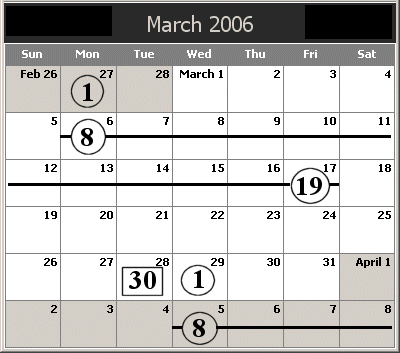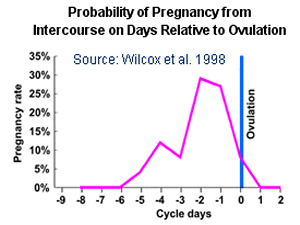Natural Family Planning: The Standard Days Method ®

The Standard Days Method (SDM) is a new method of Natural Family Planning (NFP) developed by the Institute for Reproductive Health at Georgetown University. SDM is 95% effective when used correctly. The 95% means that 5 out of 100 women practicing this method correctly for one year will get pregnant. The effectiveness of any method of NFP varies from couple to couple. All NFP methods are significantly less effective for couples who do not follow the method closely.
SDM works for women with menstrual cycles from 26 to 32 days long. To use the method, couples abstain from sexual intercourse on days 8 through 19 of the woman's menstrual cycle. If a woman has more than one cycle per year that is shorter than 26 days, or longer than 32 days, the method effectiveness decreases significantly and a different method of NFP should be used.
Using the Standard Days Method:

On any ordinary calendar, mark the day when your period first begins as Day 1 and circle it. Then mark the same day of the week, one week later, as Day 8 and circle it. Count forward to Day 19 and circle it. Draw a solid line through days 8, 9, 10, 11, 12, 13, 14, 15, 16, 17, 18, and 19. For these twelve days (days 8 through 19), abstain from all sexual intercourse, if you wish to avoid conception.
Below is an example of how to mark your calendar.

Day 8 through day 19 are days of increased fertility and increased chance of conception. Abstain from sexual intercourse on days 8 through 19 in order to avoid conception.
All other days within each cycle present a low risk of conception. You do not need to abstain from sexual intercourse on days 1 through 7, nor on day 20 through the end of each cycle.
When your next period begins, mark that day as Day 1 of the next cycle. Then go back to the previous cycle on the calendar and count the total number of days in the previous cycle.
Put a square around the total number of days for each cycle. So if a cycle was 30 days long, the last day will be marked 30.
Keep these calendar pages, so that you have a record of how long each cycle was. Only one cycle per year can be less than 26 days, or more than 32 days.
If more than one cycle per year was shorter than 26 days or longer than 32 days, use a different method of Natural Family Planning.
Using CycleBeads

Cycle Beads are another way of keeping track of the days of a woman's cycle in the Standard Days Method. She moves the marker along the beads with each passing day. She must also mark the first day of her period on a calendar, in case she forgets to move the marker. See CycleBeads.com
Why the Standard Days Method works

Researchers at the Institute for Reproductive Health at Georgetown University discovered that ovulation most often occurs about the midpoint of a woman's menstrual cycle. 30.1% of cycles had ovulation at the midpoint of the cycle. In approximately 89% of cycles, ovulation occurs within plus or minus 3 days of the midpoint day (see the midpoint day graph below).

The chance of conception from intercourse on the day of ovulation is 8 to 10%.
But SDM also takes into account the chance of conception from sexual intercourse in the days before and after ovulation. The ovum remains viable for only 12 to 24 hours after ovulation, so conception can occur from sexual intercourse no later than one day after ovulation. The sperm remain viable for 5 to 6 days after intercourse, so conception can occur from sexual intercourse up to 5 or 6 days prior to ovulation. However, the probability of conception from intercourse even 5 days before ovulation is only about 5%. The greatest chance of conception occurs one and two days before ovulation (see the probability of pregnancy graph below).

Taking into account these percentages, researchers determined a fertile window within the menstrual cycle (see the fertile window chart below) from day 8 through day 19.

They tested their method in a study of 478 women for a total of over 4,000 menstrual cycles. The study demonstrated the method to be over 95% effective with correct use. The method was 88% effective in typical usage (some couples did not always abstain during the entire fertile time). Since the study, SDM has been used by many women around the world. SDM has proven to be an effective, safe, easy-to-learn method of NFP.
Questions and Answers about the Standard Days Method (SDM)

Q: Should we use a barrier method of contraception during days 8 through 19?
A: No. You should abstain from sex during days 8 though 19. Those are the days of highest fertility. Using a barrier method during days 8 to 19 increases the failure rate substantially. Using any type of contraception to avoid periodic abstinence has the effect of replacing Natural Family Planning with contraception.
Q: Can NFP be used to achieve conception and pregnancy?
A: Yes, most NFP methods can be used to increase the likelihood of conception. SDM is less effective for that purpose than other methods.
Q: Is the Standard Days Method of NFP approved by the Catholic Church?
A: Yes. Several Roman Catholic Bishops and at least one Bishops Conference have approved the Standard Days Method of NFP.
Q: Will NFP be effective for me?
A: The effectiveness varies from one couple to another. Older couples tend to be less fertile than younger couples. To obtain the best effectiveness for you, follow the method closely and abstain from sex as indicated.
When can I being using SDM?

You should read more about the method online at: www.IRH.org
You should also receive instruction in person from a health care professional, and, if you have any related medical issues, please consult with your doctor.
Then, if the date of your last period is known, start using SDM immediately by counting the day on which your last period started as Day One.
If the date of your last period is unknown, start using SDM on the first day of your next period.
If you recently gave birth or have been breast-feeding, start using SDM after 4 periods, if your two most recent periods are about one month apart. You may breast-feed while using SDM, as long as your periods have resumed and your cycle is 26 to 32 days long.
If you have been using contraceptives, you may begin using SDM on the first day of your next period (if your cycles before using contraception were 26 to 32 days long).
Note: this information is not copyrighted and may be freely reproduced and distributed.
|
|